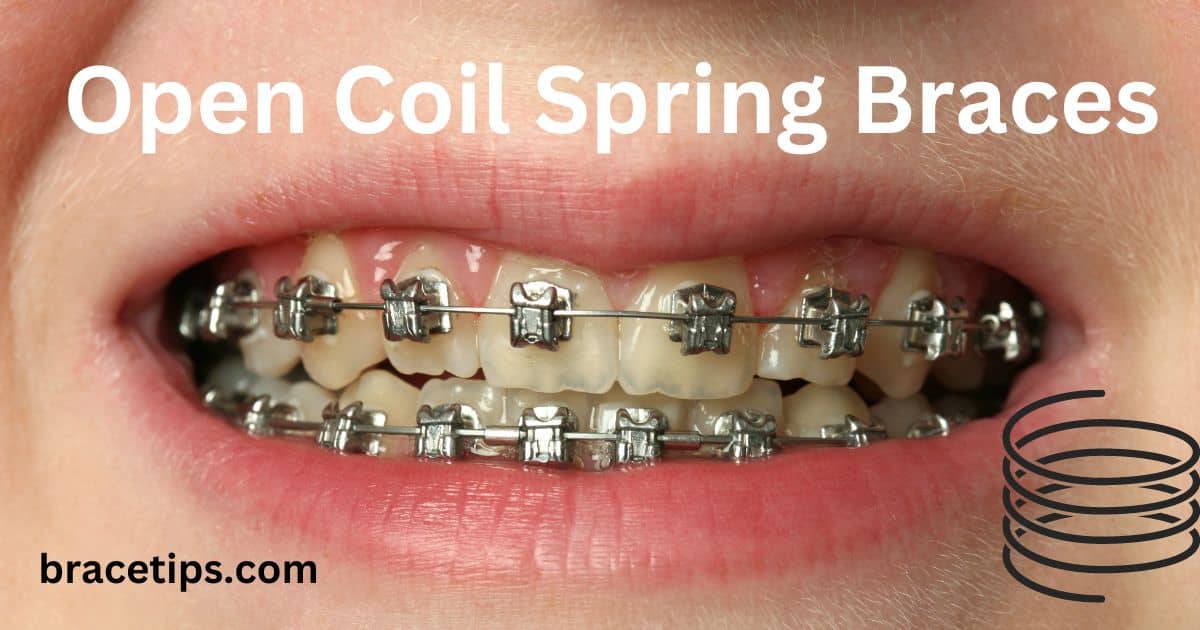Open Coil Spring Braces
Orthodontic treatments have come a long way, and one of the innovations making waves in the field is the use of Open Coil Spring Braces. These braces have gained popularity for their unique design and effectiveness in addressing various orthodontic issues. In this article, we’ll delve into the world of Open Coil Spring Braces, exploring how they work, their advantages, considerations before getting them, and much more.
What do Coil Springs do on Braces?
Open coil springs are orthodontic devices designed to provide controlled force and movement in the treatment of dental misalignments. They act as connectors between different components of braces, exerting pressure to guide teeth into their desired positions. These springs facilitate the correction of spacing issues, crowding, and various other dental irregularities.
Breaking Down the Functions
To comprehend the multifaceted nature of coil springs, let’s break down their primary functions:
Closing Gaps:
Open coil springs are adept at closing gaps between teeth. By exerting continuous pressure, they encourage teeth to move towards each other, gradually eliminating spaces.
Correcting Misalignments:
For individuals with misaligned teeth, coil springs contribute to the correction process. They aid in aligning teeth properly, fostering a harmonious bite.
Enhancing Overall Effectiveness:
Coil springs enhance the overall effectiveness of braces by introducing an element of flexibility. This dynamic force application allows for precise control over tooth movement.
Tailoring Treatment to Individual Needs
Coil springs are a versatile component in orthodontics, suitable for various dental conditions. Individuals who may benefit from open coil spring brace include:
Patients with Gaps:
Those with noticeable gaps between their teeth can benefit from the gap-closing capabilities of coil springs.
Crowding Issues:
Coil springs are effective in addressing crowding issues by creating space and rearranging teeth for an even alignment.
Complex Cases:
Orthodontic cases requiring intricate adjustments and precise tooth movement often benefit from the incorporation of coil springs.
Calculating the Need for Coil Springs
Orthodontic professionals use thorough assessments and diagnostic tools to determine the need for coil springs. Factors such as the degree of misalignment, spacing concerns, and overall oral health are considered in crafting a personalized treatment plan.
How Open Coil Spring Braces Work
Mechanism of Open Coil Springs
Open Coil Spring Braces utilize a mechanism involving small springs placed between brackets. These springs exert gentle pressure, creating space between teeth or guiding their movement. This process is crucial for addressing overcrowding or closing gaps in the teeth.
Application in Orthodontic Treatment
Orthodontists often recommend Open Coil Spring Braces to patients with specific dental misalignments. The braces are tailored to individual needs, ensuring a customized approach to orthodontic treatment.
Advantages of Open Coil Spring Braces
Improved Comfort
Unlike traditional braces, Open Coil Spring Braces offer enhanced comfort due to their innovative design. The gentle pressure exerted by the springs minimizes discomfort, making the adjustment period more manageable for patients.
Enhanced Aesthetic Appeal
These braces also score high on aesthetic appeal. The open coil design is less conspicuous, providing a visually appealing alternative for individuals conscious of their appearance during orthodontic treatment.
Faster Treatment Process
Open Coil Spring Braces are known for their efficiency in addressing orthodontic issues. The targeted pressure applied by the springs expedites tooth movement, potentially reducing the overall treatment duration.
Considerations Before Getting Open Coil Spring Braces
Consultation with Orthodontist
Before opting for Open Coil Spring Braces, a consultation with an orthodontist is crucial. The orthodontist will assess the patient’s dental condition and recommend the most suitable treatment plan.
Treatment Duration
Patients should have a clear understanding of the expected treatment duration. While Open Coil Spring Braces can expedite the process, individual cases may vary.
Cost Considerations
It’s essential to discuss the cost of treatment with the orthodontist. Factors such as the complexity of the case and additional procedures may influence the overall cost.
Real-Life Experiences with Open Coil Spring Braces
Patient Testimonials
Many individuals who have undergone treatment with Open Coil Spring Braces report positive experiences. Testimonials often highlight the improved comfort and noticeable changes in dental alignment.
Before-and-After Comparisons
Visual representations of before-and-after scenarios showcase the transformative impact of Open Coil Spring Braces. These comparisons provide prospective patients with a realistic expectation of the potential outcomes.
Common Myths and Misconceptions
Open Coil Spring Braces are Uncomfortable
Contrary to this belief, the innovative design of Open Coil Spring Braces prioritizes comfort. Patients often find these braces less uncomfortable compared to traditional alternatives.
Only Suitable for Certain Orthodontic Issues
Open Coil Spring Braces are versatile and can address various orthodontic issues, making them a suitable option for a wide range of cases.
Maintenance Tips for Open Coil Spring Braces
Proper Oral Hygiene Practices
Regular brushing and flossing, along with orthodontist-recommended techniques, help prevent issues like plaque buildup.
Regular Orthodontic Check-ups
Scheduled check-ups with the orthodontist ensure that the treatment is progressing as planned. Any adjustments needed can be addressed promptly, contributing to the overall success of the treatment.
Types of Braces Coil Springs
Tailoring Treatment to Individual Needs
Coil springs come in various types, each designed to address specific orthodontic challenges. Let’s explore the common types:
Closed Coil Springs:
These springs are more compact and are used for minor adjustments. They work well for closing small gaps and fine-tuning tooth alignment.
Open Coil Springs:
Open coil springs have a more expansive design, making them suitable for larger gaps and more significant tooth movements. They provide increased flexibility and versatility in treatment.
Short and Long Coil Springs:
Coil springs are also categorized based on their length. Short coil springs are ideal for specific tooth movements, while long coil springs provide a broader range of force application.
Function and Purpose of Braces Coil Springs
Precision in Tooth Movement
The primary function of braces coil springs is to introduce controlled force to facilitate the precise movement of teeth. This precision is crucial in achieving optimal results in orthodontic treatment. The springs work in conjunction with other components of braces to apply pressure in targeted areas, ensuring that each tooth is guided into its intended position.
Active Role in Treatment Planning
Orthodontists carefully plan the use of coil springs in the overall treatment strategy. The specific force and direction applied by the springs are customized for each patient, taking into account their unique dental anatomy and the desired outcome. This personalized approach highlights the active role that coil springs play in achieving successful orthodontic results.
How Braces Coil Springs Work
The Science Behind the Springs
Coil springs operate on the basic principle of elasticity. Composed of high-quality materials, these springs have the ability to deform under applied force and return to their original shape once the force is removed. In the context of braces, this elasticity is harnessed to induce controlled tooth movement.
Sequential Force Application
Orthodontic treatment involves a series of adjustments, and coil springs contribute by providing sequential force application. As the springs are compressed or expanded, they generate the necessary force to move teeth gradually. This sequential approach ensures a steady and controlled pace of tooth movement, minimizing discomfort for the patient.
Interaction with Archwires
Coil springs interact with archwires, another essential component of braces. Archwires transmit the force generated by coil springs to the brackets, guiding the movement of each tooth. This collaborative effort between coil springs and archwires allows for a comprehensive and targeted approach to orthodontic correction.
Potential Challenges and Side Effects
Addressing Concerns for Informed Decision-Making
While open coil springs contribute significantly to successful orthodontic treatment, it’s essential to be aware of potential challenges and side effects:
Oral Hygiene Challenges:
The presence of coil springs can make oral hygiene practices more challenging. Thorough brushing and flossing become crucial to prevent plaque buildup around the springs.
Adjustments and Tightening:
Regular adjustments and tightening sessions with the orthodontist are necessary to ensure that the coil springs continue to apply the required force for effective tooth movement.
Caring for Coil Springs
Maintaining Optimal Functionality
Proper care and maintenance are essential to ensure the longevity and effectiveness of coil springs in orthodontic treatment:
Regular Dental Check-ups:
Routine dental check-ups allow orthodontists to monitor the condition of the coil springs and make any necessary adjustments.
Oral Hygiene Practices:
Diligent oral hygiene practices, including thorough brushing and flossing, are crucial to prevent plaque accumulation around the coil springs.
Adhering to Orthodontist’s Recommendations:
Following the orthodontist’s recommendations regarding dietary restrictions, appliance care, and scheduled appointments is vital for successful treatment.
Alternatives to Open Coil Spring Braces
Traditional Braces
Traditional braces remain a reliable option for many orthodontic cases. They consist of brackets and wires that work together to align the teeth gradually.
Invisalign
Invisalign offers a discreet alternative to braces. These clear aligners are removable and gradually shift the teeth into the desired position.
Choosing the Right Orthodontic Option for You
Personalized Consultation
The decision between Open Coil Spring Braces, traditional braces, or Invisalign should be based on a personalized consultation with the orthodontist. Factors such as lifestyle, preferences, and treatment goals play a significant role in making the right choice.
Treatment Goals
Whether it’s addressing specific dental issues or achieving a more aesthetically pleasing smile, communicating these goals with the orthodontist helps tailor the treatment plan accordingly.
Future Developments in Orthodontics
Technological Advancements
The field of orthodontics is witnessing continuous technological advancements. From 3D imaging for treatment planning to innovative materials, the future holds promising developments for more effective and efficient orthodontic treatments.
Evolving Trends in Braces
As technology evolves, so do the trends in braces. Future braces may incorporate even more discreet designs and faster treatment options, catering to the preferences of a diverse patient population
FAQ Section
Q: How long does it take to adjust to Open Coil Spring Braces?
A: The adjustment period varies among individuals but is generally shorter due to the braces’ innovative design prioritizing comfort.
Q: Can Open Coil Spring Braces be used for all age groups?
A: Yes, Open Coil Spring Braces are suitable for various age groups, including adolescents and adults.
Q: Do they cause speech difficulties?
A: No, Open Coil Spring Braces typically do not cause speech difficulties, and most individuals adapt quickly to speaking with them.
Q: Are there any dietary restrictions with Open Coil Spring Braces?
A: While there are no strict dietary restrictions, it’s advisable to avoid certain foods that may damage the braces, such as sticky or hard candies.
Q: What is the average cost of Open Coil Spring Braces treatment?
A: The cost varies based on individual cases and additional procedures but can be discussed with the orthodontist during the consultation.
Q: What factors determine how long coil springs stay on braces?
A: Factors include the complexity of the orthodontic case, the desired tooth movement, and the patient’s overall oral health. Orthodontists assess these factors to determine the optimal duration for coil spring use.
Conclusion
Open Coil Spring Braces represent a modern and effective approach to orthodontic treatment. Their innovative design, coupled with the advantages of improved comfort and aesthetic appeal, makes them a popular choice for individuals seeking orthodontic solutions. Before making a decision, it’s essential to consult with an orthodontist, discuss treatment goals, and consider factors like comfort and aesthetics. The functions, types, and maintenance considerations associated with coil springs empowers individuals undergoing orthodontic treatment to actively participate in their oral health journey. As with any orthodontic appliance, regular communication with the orthodontist and diligent self-care contribute to successful outcomes, ensuring a confident and healthy smile.

